
Hair Care
Skin care
KEYWORDS
peer-reviewed
A new conditioner derived from PCA and Polyglycerin
Arianna Malà
R&D specialist, SALT srl, Borgo Trevi (PG), Italy.
ABSTRACT: Common hair conditioning agents, such as quaternary ammonium salts, can cause skin and eye irritation and persist in the environment due to poor biodegradability. To address the demand for safer and more sustainable cosmetic ingredients, a new conditioning agent was developed from vegetable-derived raw materials using green chemistry principles. The goal was to create a safe, eco-friendly alternative with performance comparable to conventional agents. The compound, synthesized from pyrrolidone carboxylic acid (PCA), polyglycerin, and ricinoleic acid, was characterized through NMR spectroscopy. Toxicological assessments confirmed an excellent tolerability profile with a cell viability > 99% and μ (mean of MII) = 0.0. Preliminary in vivo tests showed conditioning effects similar to a benchmark formulation, containing CTAC, with an improvement in combability on wet hair (5 out of 5 against 4 out 5 of the benchmark) and slightly weaker film-forming properties (3 out of 5 against 4 out 5 of the benchmark). Overall, this new PCA- and polyglycerol-derived surfactant is a promising eco-friendly conditioning ingredient for both hair- and skin-care formulations.
??????????????????
“
“A study in healthy women providing probiotic yogurt for four weeks showed an improvement in emotional responses as measured by brain scans”
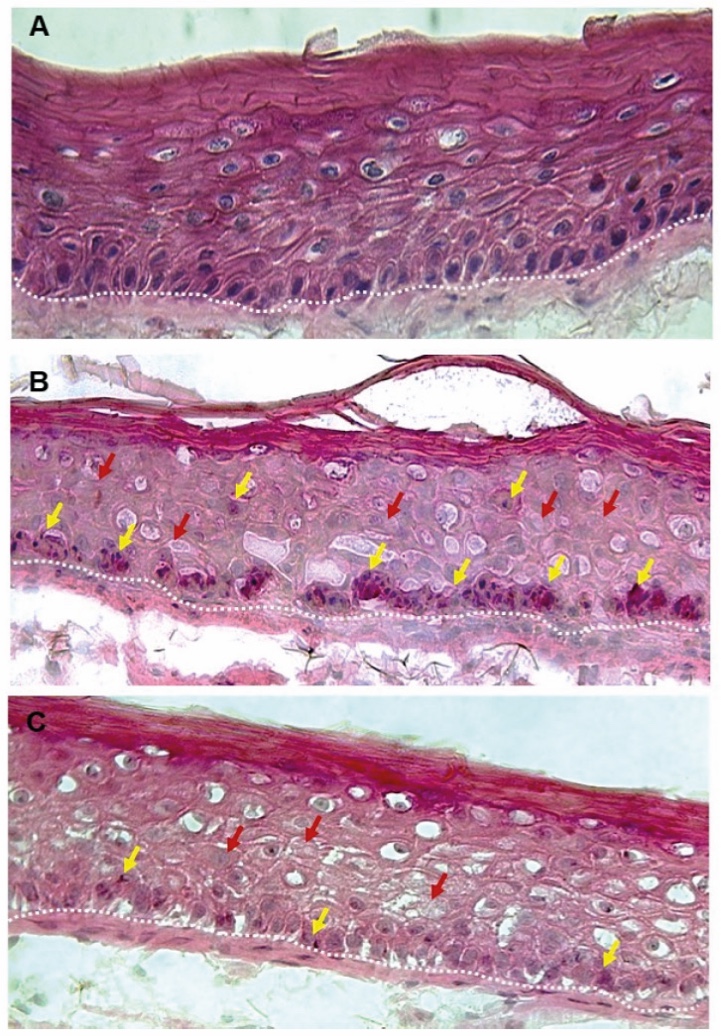
Figure 1. Skin Section with Microbiome. Most microorganisms live in the superficial layers of the stratum corneum and in the upper parts of the hair follicles. Some reside in the deeper areas of the hair follicles and are beyond the reach of ordinary disinfection procedures. There bacteria are a reservoir for recolonization after the surface bacteria are removed.
Materials and methods
Studies of major depressive disorder have been correlated with reduced Lactobacillus and Bifidobacteria and symptom severity has been correlated to changes in Firmicutes, Actinobacteria, and Bacteriodes. Gut microbiota that contain more butyrate producers have been correlated with improved quality of life (1).
A study in healthy women providing probiotic yogurt for four weeks showed an improvement in emotional responses as measured by brain scans (2). A subsequent study by Mohammadi et al. (3) investigated the impacts of probiotic yogurt and probiotic capsules over 6 weeks and found a significant improvement in depression-anxiety-stress scores in subjects taking the specific strains of probiotics contained in the yogurt or capsules. Other studies with probiotics have indicated improvements in depression scores, anxiety, postpartum depression and mood rating in an elderly population (4-7).
Other studies have indicated a benefit of probiotic supplementation in alleviating symptoms of stress. In particular, researchers have looked at stress in students as they prepared for exams, while also evaluating other health indicators such as flu and cold symptoms (1). In healthy people, there is an indication that probiotic supplementation may help to maintain memory function under conditions of acute stress.
Introduction
Conditioners are post-shampoo treatments that aim to give the hair a soft, smooth feel and a shiny, glossy appearance. They protect hair from damage by creating a thin film over the fiber and decreasing its static electricity, thus facilitating combing and reducing “flyaways” (1, 2).
Hair conditioners can be classified into:
- cationic conditioners, mainly cationic surfactants (quaternary ammonium compounds, such as cetrimonium chloride and behentrimonium methosulphate);
- film-forming conditioners, high molecular-weight polymers that can be positively charged (e.g. polyquaterniums, such as polyquaternium-7), reducing static electricity and frizz;
- protein-based conditioners, soluble peptides that are derived from the partial hydrolysis of collagen or keratin or plant-derived proteins, which penetrate the hair shaft, restoring the lost proteins and repairing damaged hair (3).
Polyquaternium-7 (Fig. 1a), Polyquaternium-10 (Fig. 1b), cetrimonium chloride (CTAC) (Fig. 1c) and behentrimonium chloride (BTAC) (Fig. 1d) are among the most common hair conditioners on the market. However, they may cause skin and eye irritation and are reported to have adverse effects on the environment, especially aquatic ecosystems, in which their poor biodegradability can have long-term impact. Given the growing awareness of consumer s on human health, environmental and social issues, there is an increasing need for ingredients and formulations to have a lower impact on human health and the environment, while still delivering the desired conditioning effects, as wet and dry combing forces, rheological properties and product stability (3, 4).

Figure 1. Common hair conditioning agents: (a) Polyquaternium-7 (copolymer of diallyl dimethyl ammonium chloride and acrylamide), (b) Polyquaternium-10 (cationic hydroxyethyl cellulose), (c) Cetrimonium chloride (CTAC), (d) Behentrimonium chloride (BTAC). Structure generated using MarvinSketch (5).
To meet the growing demand for more sustainable products, this study aimed to design, synthesize, and evaluate a novel cationic conditioning agent that is derived from natural raw materials, considering that several alternative strategies to conventional conditioning agents have already been explored, including:
- Protein-based conditioners, aforementioned.
- Vegetable-based lipids, which have conditioning properties by replacing the hair’s natural lipidic layer and restoring the hydrophobic character of the hair shaft.
- Proteins and fatty acids in specific proportions (respectively 21.9% and 64.2%) can be used to produce lipopeptide biosurfactants which are adsorbed efficiently on the hair surface and restore its lipidic layer (3).
- Esterquats are quaternary ammonium cationic surfactants that derive from alkanolamines esterified with fatty acids form vegetable sources, offering enhanced biodegradability and lower aquatic toxicity due to their cleavable ester bond (3, 6).
- Amino-acid based biosurfactant, such as Brassicyl Valinate Esylate (BVE), known as AminoSensylTM, which derives from valine and Brassica napus seed oil and valine (3).
The compound developed in this work was designed with two primary objectives: a) conditioning performance comparable to conventional agents, and b) good tolerability.
Material and methods
The objectives of this research were pursued through several sequential steps. First, the conditioning agent was designed, followed by the evaluation and selection of raw materials consistent with the concept of sustainability. The compound was then synthesized using the Twelve Principles of Green Chemistry (7). The resulting product was characterized by NMR spectroscopy and subsequently subjected to toxicological assessments and preliminary efficacy tests to evaluate respectively its safety andconditioning properties.
Materials
The design phase led to the identification and selection of the following raw materials:
- Pyrrolidone carboxylic acid, PCA (“Ajidew™” A-100” by Ajinomoto Co, Tokyo, Japan), a secondary amino acid that derives from L-glutamic acid and constituent of the skin NMF (Natural Moisturizing Factor) and a natural humectant (8-10).
- Pure vegetable polyglycerine-4, by Spiga Nord (Carasco (GE), Italy), a glycerin-derived oligomer with hydroxy groups that can form polyglycerol esters (PGFEs), widely used as emulsifiers, solubilizers, stabilizers, and skin/hair conditioners (11, 12).
- Ricinoleic acid, a hydroxy- and double-bond-containing fatty acid abundant in castor oil (Ricinus Communis Seed Oil) conferring moisturizing and nourishing properties. It was supplied by GiomaVaro, Brughiero (MB), Italy (13, 14).
Nuclear Magnetic Resonance (NMR) spectroscopy – quantitative analysis
The analysis was conducted by DelphiStarLab at the University of Perugia by using a Brucker AVANCE NEO 600 equipped with the CryoProbe Prodigy™. The inverse gated 13C{H1} NMR spectrum was registered by using a zgig30 pulse sequence from the Bruker library with a dwell time of 11s. The chemical shifts of 1H and 13C relate to the solvent or/and to the external tetramethylsilane.
The spectrum was obtained by dissolving 0.2 ml of the tested compound in 0.6 ml of methanol, was recorded using 64,000 points, 256 scans and processed with a line broadening of 1.0 Hz. To avoid both the alteration and the contamination of the samples, the lock and shimming routing were perfomed using a glass capillary containing DMSO-d6 immersed in the sample solution.
Formulation preparation
The synthesized compound was incorporated in a formulation developed by ML Kosmetik Italia for preliminary in vivo efficacy and toxicological testing (patch test). The formula is deliberately simple to assess the functionality of the conditioning agent while minimizing interference from other active ingredients. For instance, no perfume was added to allow the evaluation of the effects of the compound on the odour. Its performance was compared to a benchmark formulation of identical composition, except that cetrimonium chloride (CTAC) served as the conditioning agent. Formulation details are presented inTable 1.
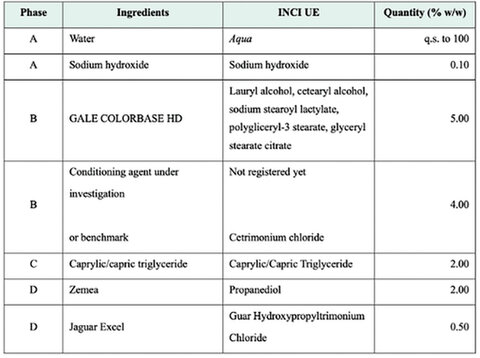
Table 1. General composition of the hair conditioning formulation. Both formulations share the same base composition; in Phase B, was incorporated either the tested conditioning agent or the benchmark.
The final pH of each formulation sample was between 4.5 and 5, which is the optimal range to cationize the keratin surface and reduce the electrostatic charges (15).
Toxicological assessment
The compound synthesized, before being tested on models, underwent local toxicity studies, such as a cytotoxicity test (in vitro) and a skin irritation test (in vivo), that were conducted by B-RES Clinical.
MTT Assay
The assay protocol was conducted in accordance with the UNI EN ISO 10993-5:2009 guidelines (Biological evaluation of medical devices - Part 5: Tests for in vitro cytotoxicity) (16). The sample was prepared as a 10% w/w distilled water solution, used as a stock solution for further dilutions required by the culture medium test and expressed as concentration (% w/w) = 100% w/w in Table 3. L929 murine fibroblasts, known for their sensitivity to cytotoxici agents, were seeded in a 96-well plate and incubated for 24 hours at 37°C to obtain a half confluent monolayer. The different dilutions of the compound were added and incubated for 24 hours at 37°C, with each concentration assessed in duplicate.
MTT solution was added to the cell culture and incubated for 3 hours, after which the resulting formazan crystals were solubilized in a PBS (Phosphate Buffer Saline) solution and absorbance measured at 570 nm using a microplate reader.
Results were compared to untreated cells, and cell viability (%) was determined using Eq. 1 (17):

Eq. 1. Cell viability percentage
Single application patch test
The single application patch test was conducted on 40 volunteers, selected based on the following inclusion criteria: normal skin, age 18–65, absence of dermatological or systemic conditions, and provision of informed consent. Exclusion criteria included pregnancy, nursing, skin irritation or lesions at the test site, use of relevant medications, known contact allergies to the product, and participation in other clinical studies without an appropriate washout period. Of these volunteers, 20 received the single compound, while the remaining 20 were treated with the tested formulation. Both were applied through an occlusive chamber containing 20 mg/ml of a 10% aqueous solution of the respective test substances for 48 hours. The clinical assessment was performed immediately after patch removal at subsequent time points: 30 minutes (T1) and 24 hours (T2).
At the end of data collection, to assess the compound irritating potential, the MII (Mean Irritation Index) was calculated (Eq. 2):

Eq. 2. MII (Mean Irritation Index) of individual subjects.
And the µ (mean of MII) (Eq. 3):
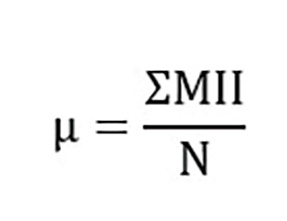
Eq. 3. Mean (μ ) of MII (Mean Irritation Index).
where ∑MII is the sum of the individual MII scores and N is the number of subjects. The values obtained were interpreted according to Table 2.

Table 2. Classification of the Mean Irritation Index (MII) (adapeted from the amended Draize classification) (18).
Preliminary efficacy tests
Combing resistance evaluation
The preliminary test evaluated the conditioning effect of leave-on cosmetic products, particularly in relation to hair breakage resistance and structure. This unblinded preliminary study was conducted by B-RES Clinical on four female volunteers aged 18–60 years, selected for normal scalp skin, damaged, dry, or frayed hair, no psychological or cognitive disorders, and provision of informed consent. Volunteers’ hair was washed, blot-dried, treated with the formulation for five minutes, and rinsed. Combability, defined as the perceived ease of combing, was assessed before (t0) and after treatment (t1) by measuring the breaking load (N) using a dynamometer (IMADA, model MH2-500N) (19). This device continuously records the resistance forces along the hair strand from the root to the tip, with the following settings: speed of terminal: 100 mm/min, load cell ID/FS[N]: 20 N, test-piece length: 50 mm, pretension: 5 cN (each measurement is the average of five hairs). Statistical analysis was performed using a paired t-test with a significance threshold of 5%.
Hair structure was analyzed through sensorial evaluation by experts to assess combability, touch and shine. Each parameter was rated on a 1–5 scale (1 = no variation; 5 = very marked variation) based on the median.
In vivo evaluation of conditioning performance
A preliminary in vivo study was conducted by a trained panel from ML Kosmetik Italia, which assessed the formulation sample in comparison to a benchmark conditioner, on eleven female volunteers aged 25–65 years. Participants were enrolled based on the following inclusion criteria: normal scalp skin, damaged hair, hair length of 20–30 cm or longer and provision of informed consent.
Each volunteer underwent hair washing, followed by the application of approximately 5 g of each formulation to two separate hair sections. The test formulation was applied to the right side and the benchmark to the left side (Fig. 2). The conditioners were left on for five minutes, then hair was rinsed with abundant water and blot dried on a towel. Finally, hair was naturally blow-dried and styled.
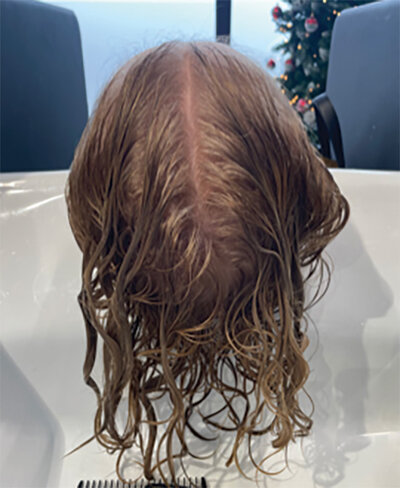
Figure 2. Application of the hair conditioner formulations on volunteers: the hair was divided into two sections, the benchmark formulation (CTAC) was applied to the left side and the new conditioning formulation was applied to the right side.
A qualified panel evaluated the tested conditioner for organoleptic properties (colour, odour, texture), yield (quantity of product needed for even distribution across the entire hair surface), formulation distribution, hair combability, texture, conditioning and brushing. Colour, odour and texture, were evaluated before application, whereas yield and distribution were assessed during application. Combing was assessed before and after the product application to detect changes in friction. Conditioning and film-forming properties were evaluated before and after application, including after blow-drying and styling. In the final phase, brushing was assessed. All properties, except colour, were rated on a 1–5 numeric scale (1 = excellent, 5 = very poor) based on the median. The procedure was described and conducted by qualified personnel from ML Kosmetik Italia.
Results and discussion
Nuclear Magnetic Resonance (NMR) spectroscopy – quantitative analysis results
Due to confidentiality, data on the synthesis pathways and the NMR spectroscopy method and results cannot be provided. However, the integration of the ^13C{^1H} NMR inverse-gated spectrum, comparing (a) the resonances of the carbonyl groups of the esterified fatty acids with that of the free fatty acid, and (b) the resonances of the carbonyl groups of PCA with that of the free PCA, demonstrated a high conversion rate for both the fatty acid (98%) and PCA (95%). In conclusion, the compound was obtained with an optimal reaction yield, supporting its suitability for further toxicity and performance evaluations.
MTT assay
The results presented in Table 3 indicate that the compound did not show cytotoxic effects at any tested concentration, with cell viability consistently showing values > 99% (Mean OD blank = 0.605).
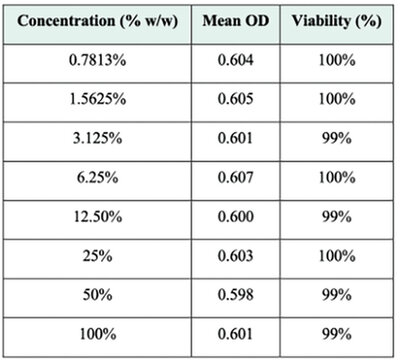
Table 3. Mean values of optical density (OD) and cell viability (%) obtained from MTT assay at different concentrations (mean of two replicates).
Single application patch test results
The conditioning agent showed a µ = 0.00, while the formulation had µ = 0.03. Both the compound and the formulation can be considered non-irritating and well tolerated across all skin types. The slight difference in µ values is likely attributed to other formulation components.
Preliminary combing resistance evaluation results
The preliminary test resulted in an increase of the breaking load (N) after the product application, with mean and standard deviation values indicating good repeatability of the test (Table 4).
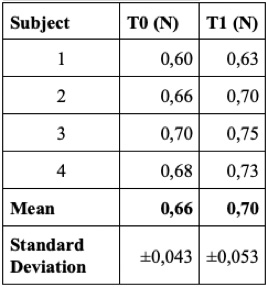
Table 4. Breaking load (N) results before (T0) and after (T1) treatment for each subject, with mean values, show a slight increase after product application. The mean and standard deviation indicate good repeatability of the test.
Sensorial evaluation showed that the hair treated exhibited an improved combability (median: 3 out of 5), texture (median: 4 out of 5) and shine (median: 4 out of 5) compared to the untreated hair.
Preliminary results of in vivo conditioning performance evaluation
The green formulation, containing the investigated compound, was compared to a benchmark formulation with cetrimonium chloride (CTAC). Organoleptic evaluation showed that the formulation was odourless, similar to the benchmark, offering an advantage over the marketed products such as behentrimonium chloride and methosulphate, which require perfumes because of their characteristic odour. The formulation showed a creamy colour and consistency comparable to the benchmark, with similar application, distribution, and rinsing performance. Regarding the conditioning performance, the sample exhibited similar performance to the benchmark, in terms of combability, texture and shine . Combability, evaluated by the trained panel using a comb, resulted slightly superior on wet hair (5 out of 5) and marginally inferior (3 out of 5) on dry hair compared to the benchmark (4 out of 5, for both wet and dry hair); the film-forming properties were less effective, resulting in a reduced shine and a lower electrostatic effect (3 out of 5 for the compound, 4 out of 5 for the benchmark). As in Fig. 3, hair treated with the formulation under investigation (right side) appeared slightly frizzier and less disciplined.

Figure 3. Result of the in vivo test: hair treated with the new formulation (right side) appeared slightly frizzier and less disciplined compared to the benchmark (left side).
Conclusions
A new conditioning agent based on pyrrolidone carboxylic acid (PCA), polyglycerin and ricinoleic acid, was developed as a sustainable alternative to traditional conditioning agents. Synthesized using green chemistry principles and natural, biodegradable ingredients, it demonstrated excellent tolerability in toxicological assessments, including in vitro cytotoxicity and in vivo skin irritation tests. Preliminary in vivo efficacy studies showed conditioning performance comparable to the benchmark formulation, with good combability, acceptable shine, and favorable sensorial properties, although filming and antistatic effects were slightly weaker. Overall, preliminary results indicate that the conditioning agent is a valid and sustainable option for hair-care formulations. Future studies should evaluate its conditioning effect on hair in larger groups of volunteers, its moisturizing properties on skin, and potential applications across a variety of skin- and body-care products.
Conclusion
The future of cosmetics lies in the continued evolution of holistic approaches which represents a transformative shift in the industry, merging scientific advancements, natural ingredients, and wellness principles. By understanding and embracing the interconnectedness of these elements, the cosmetics industry can cultivate products that not only enhance external beauty but also contribute to the overall well-being of individuals and the planet.
The interplay between beauty from within and topical cosmetics is the key for future products. The integration of biotechnology and green chemistry is revolutionizing cosmetic formulations, offering sustainable and biocompatible alternatives.
Developers can implement blockchain to trace the journey of ingredients from source to product. Nevertheless, the efficacy of the natural products should be scientifically proven. Marketers can communicate transparency as a brand value, and parallelly educate consumers by highlighting how specific ingredients contribute to radiant and healthy skin.
By embracing the synergy between these approaches and leveraging scientific advancements, the cosmetics industry can provide consumers with comprehensive beauty solutions that cater to both internal and external dimensions of beauty.
Surfactant Applications
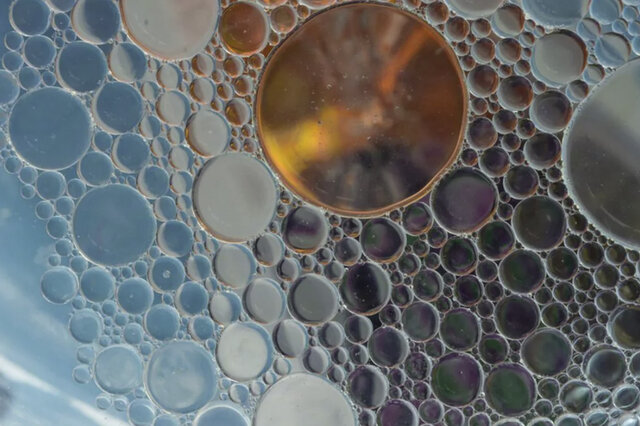
The application area lends itself particularly well to the use of AI. Active today in this area is the US company Potion AI (6). The company provides AI-powered formulation tools for beauty and personal care R&D. Their offerings include Potion GPT, next generation ingredient and formula databases and AI document processing. Potion’s work could have a significant impact on the entire surfactant value chain, from raw material suppliers to end consumers. By using their GPT technology, they can help target work toward novel surfactant molecules that have optimal properties for specific applications. By using their ingredient and formula databases, they can access and analyze a vast amount of data on surfactant performance, safety, and sustainability. By using their AI document processing, they can extract and organize relevant information from patents, scientific papers, and regulatory documents. These capabilities could enable Potion AI's customers to design and optimize surfactant formulations that are more effective, eco-friendly, and cost-efficient. A particularly interesting application for this type of capability is deformulation.
Deformulation is the process of reverse engineering a product's formulation by identifying and quantifying its ingredients. Deformulation can be used for various purposes, such as quality control, competitive analysis, patent infringement, or product improvement. However, deformulation can be challenging, time-consuming, and costly, as it requires sophisticated analytical techniques, expert knowledge, and access to large databases of ingredients and formulas.
AI can potentially enhance and simplify the deformulation process by using data-driven methods to infer the composition and structure of a product from its properties and performance. For example, AI can use machine learning to learn the relationships between ingredients and their effects on the product's characteristics, such as color, texture, fragrance, stability, or efficacy. AI can also use natural language processing to extract and analyze information from various sources, such as labels, patents, literature, or online reviews, to identify the possible ingredients and their concentrations in a product.
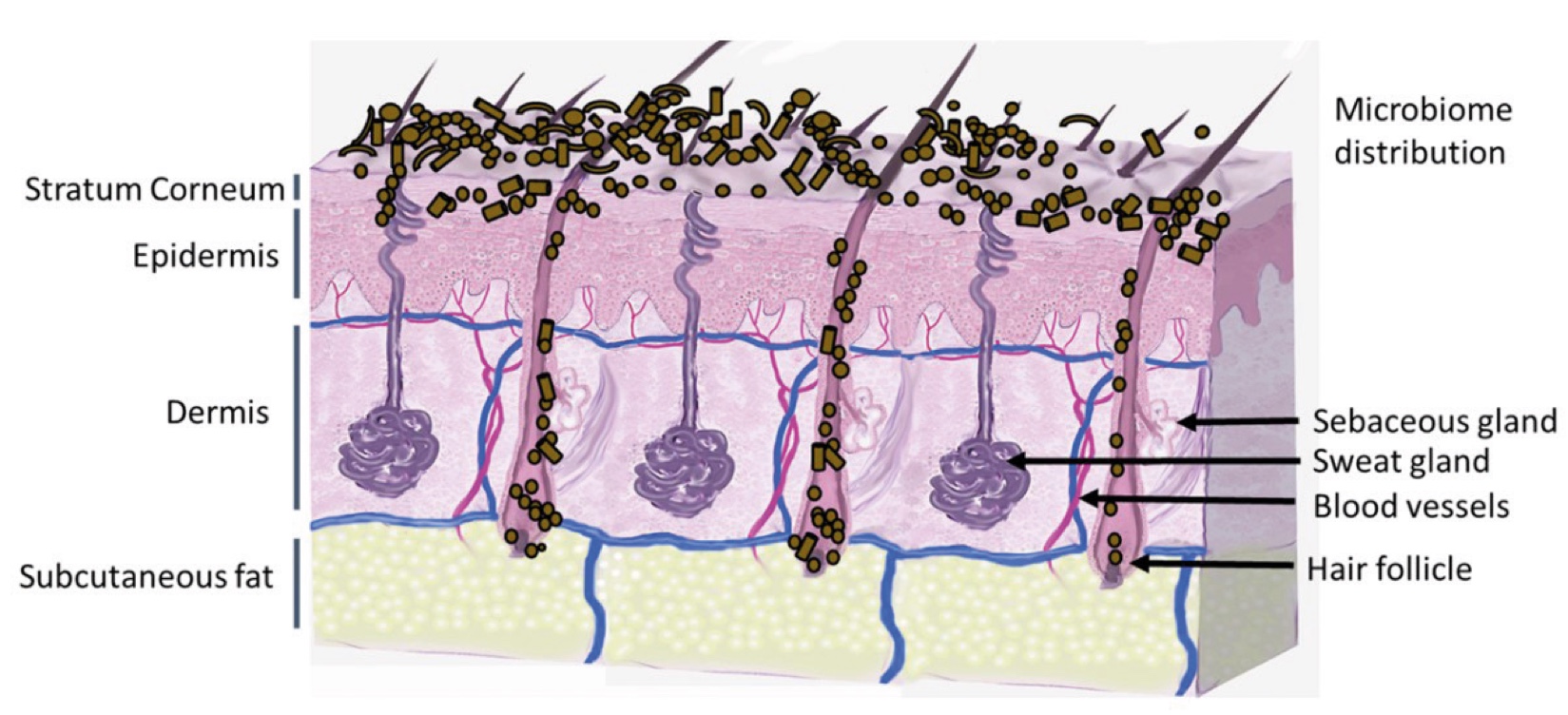
Figure 2. Skin Section with Microbiome. Most microorganisms live in the superficial layers of the stratum corneum and in the upper parts of the hair follicles. Some reside in the deeper areas of the hair follicles and are beyond the reach of ordinary disinfection procedures. There bacteria are a reservoir for recolonization after the surface bacteria are removed.
References and notes
- Bhushan B. Nanoscale characterization of human hair and hair conditioners. Prog Mater Sci. 2008;53(4):585-710. https://www.sciencedirect.com/science/article/abs/pii/S0079642508000029
- Pereira-Silva M et al. Nanomaterials in hair care and treatment. Acta Biomater. 2022;142:14-35. https://www.sciencedirect.com/science/article/pii/S1742706122001015
- Fernandes C, Medronho B, Alves L, Rasteiro MG. On hair care physicochemistry: from structure and degradation to novel biobased conditioning agents. Polymers (Basel). 2023;15(3):608. https://www.mdpi.com/2073-4360/15/3/608
- Arnold WA et al. Quaternary ammonium compounds: a chemical class of emerging concern. Env Sci Techol. 2023;57(20):7645-65. https://pubs.acs.org/doi/full/10.1021/acs.est.2c08244
- ChemAxon. MarvinSketch [Internet]. Budapest, Hungary: ChemAxon [cited 2025 Sep 21]. Available from: https://chemaxon.com/products/marvin
- Wysocki M, Stachowiak W, Smolibowski M, Olejniczak A, Niemczak M, Shamshina JL. Rethinking the Esterquats: Synthesis, Stability, Ecotoxicity and Applications of Esterquats Incorporating Analogs of Betaine or Choline as the Cation in Their Structure. Int J Mol Sci. 2024; 25(11):5761. https://www.mdpi.com/1422-0067/25/11/5761
- Anastas P, Eghbali N. Green chemistry: principles and practice. Chem Soc Rev. 2010;39(1):301-12. https://pubs.rsc.org/en/content/articlelanding/2010/cs/b918763b
- Zahradníčková H, Opekar S, Řimnáčová L, Šimek P, Moos M. Chiral secondary amino acids, their importance, and methods of analysis. Amino Acids. 2022;54(5):687-719. https://pubmed.ncbi.nlm.nih.gov/35192062/
- Gunnarsson M, Mojumdar EH, Topgaard D, Sparr E. Extraction of natural moisturizing factor from the stratum corneum and its implication on skin molecular mobility. J Colloid Interface Sci. 2021;604:480-91. https://www.sciencedirect.com/science/article/pii/S0021979721010705
- Ajinomoto Co., Inc. Ajidew™ A-100N. [Internet]. Ajinomoto AminoScience Division; [cited 2025 Sep 20]. Available from: https://ajiaminoscience.eu/personalcare/produit/ajidew-a-100n/
- Zhang M, Zhang G. Recent advances in the properties and applications of polyglycerol fatty acid esters. Polymers (Basel). 2025;17(7):e879. https://www.mdpi.com/2073-4360/17/7/879
- Spiga Nord S.p.A. Pure Vegetable Polyglycerine-4. Carasco (GE), Italy: Spiga Nord S.p.A.; [cited 2025 Sep 20]. Available from: https://www.spiganord.it/polyglycerols-pure-vegetable-polyglycerine-4_c2_p7/
- Mysore V, Arghya A. Hair oils: indigenous knowledge revisited. Int J Trichology. 2022;14(3):84-90. https://pmc.ncbi.nlm.nih.gov/articles/PMC9231528/
- Gioma Varo Srl. Gioma Varo Srl [Internet]. Brughiero (MB), Italy: Gioma Varo Srl [cited 2025 Sep 20]. Available from: https://www.giomavaro.it/index.php/it/#
- D’Agostinis G, Mignini E. Manuale del cosmetologo. 3rd ed.Milano: Tecniche Nuove; 2022.
- ISO. ISO 10993:2009 [Internet]. Geneva: International Organization for Standardization; [cited 2025 Jul 28]. Available from: https://www.iso.org/standard/36406.html
- Kamiloglu S, Sari G, Ozdal T, Capanoglu E. Guidelines for cell viability assays. Food Front. 2020;1(1):332-49. https://iadns.onlinelibrary.wiley.com/doi/10.1002/fft2.44
- Draize JH, Woodard G, Calvery HO. Methods for the study of irritation and toxicity of substances applied topically to the skin and mucous membranes. J. Pharmacol. Exp. Ther. 1944; 82:377–390.
- Velasco MVR et al. Hair fiber characteristics and methods to evaluate hair physical and mechanical properties. Braz J Pharm Sci. 2009;45(1):153-62. https://www.scielo.br/j/bjps/a/XZrwDJrKKXh4Q3JwswHJ4vq/?format=pdf&lang=en
